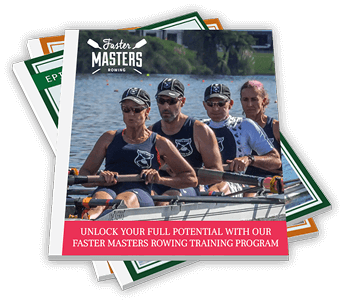The power phase is most effective when legs drive first and back follows yet so few masters rowers do this. Why?
Timestamps
00:45 Good power phase requirements
The alignment of the womens double in the photo shows that the crew hasn't used their back while having legs nearly straight. Getting into this position requires having shoulders sternwards of the hips at the catch and to use their legs first in the power phase.
03:00 Pulling with arms is easy
We have a lot of practice using hands and arms in daily life. We are good at this. At the catch you want to feel the oars loaded up under the water surface. If you pull with your arms you feel this earlier. By pulling with your arms and lifting the shoulders and lifting your chin you feel the workload on the spoon.
Rowing is a pushing not a pulling sport in the main. Rowing legs only is 60% of the power; back swing is 25-30% of your power and so your arms add 5-10% of your power ONLY.
06:00 Small muscles v big muscles
The rowing stroke uses a range of body muscles from legs, thighs and calves through to arms and hands. In daily life we use small muscles a lot - they fire quickly when we use them in daily life. We are practiced using them.
The quads and glutes are slower to activate so we have to train them - we're less habituated using these. Connecting the handle of the oars through the footstretcher is unfamiliar and you have to train it.
The first activation in the power phase is the calves to push the heels down onto the footstretcher. Then the quads join in to straighten your legs. When your legs are 3/4 straight you start the glute activation - hinging to connect legs to the back. Using the glutes to sustain pressure on the footstretcher while you swing your back. If you lose pressure on the footstretcher you are no longer accelerating the boat. Your feet are the only part of your body connected to the boat. As your back starts to activate you draw with your arms.
10:00 Why delaying the back is hard
Connecting to the footstretcher early in the power phase is our goal. If you take the catch with the arms or swinging the shoulders/back this is a problem. When delivering power through the stroke you can only use each muscle group once per stroke.
If you swing your back to take the catch you've got no back swing to use later in the power phase because you are already leaning backwards. It also prevents you from activating your leg drive - they do straighten but not as dynamically as you should. By not activating your legs this removes up to 60% of your possible total power which is a lot. And as a consequence you probably don't activate your glutes because you aren't using your legs enough.
There's a correlation between the water being slower at the catch than later in the stroke. The angle of the oar spoon is also going into the slower water at an acute angle to the side of the boat. Use the slower water speed along the slower muscles to generate that early power in the stroke.
15:00 The solution to delaying your back swing Is to train yourself to use the big muscles, learn what it feels like to activate the quads and glutes early in the stroke. Then you know what it feels like to grip the water at the catch with your feet (rather than hands or shoulders).
This is the beginning point to learn how to activate big muscles first and layer the smaller muscles on top as later activations.
Scroll down for more resources
Resources and further reading
- Delaying backswing is hard to do - podcast [15 minutes]
- Making Technical Gains with Physical Compromises - video and ebook [1 hour]
- Shoulder lifting in rowing - video [23 minutes]
- Sculling Intensive Day 5 is about catches with drills to try - self-coached camp [6 hours]
- Rushing and shoulder lifting - podcast [15 minutes]

